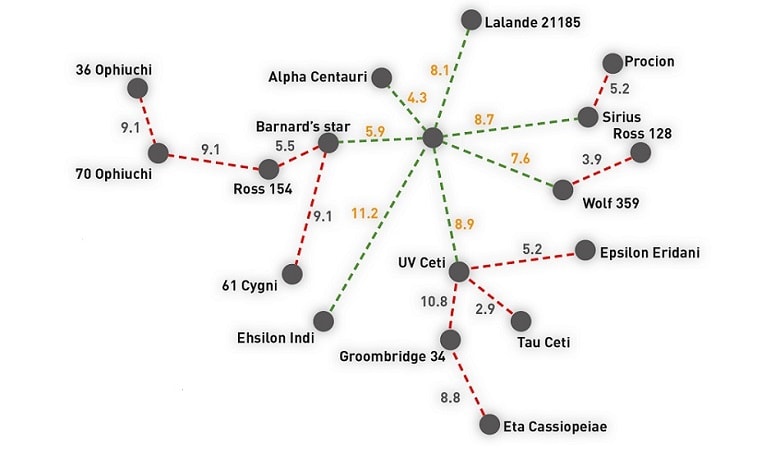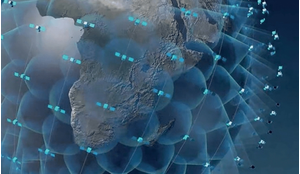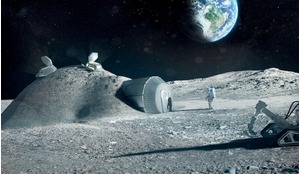All the way back in 1911, Russian rocket scientist Konstantin Tsiolkovsky created the first technical outline of an interstellar rocket. Here is what he wrote about it: “…If it were possible to sufficiently speed up the decay of radium and other radioactive solids, as all solids, perhaps, we could create such reactive power that the trip to the nearest sun (star) could be shortened to 10-40 years. In that case, a rocket weighing a tonne could completely clear the solar system using just a pinch of radium.”1
Until the 1950s, projects on interstellar travel pretty much repeated Tsiolkovsky’s ideas. Yet after nuclear weapons were created, more detailed plans for interstellar travel emerged. These included Freeman Dyson’s Orion study, based on nuclear pulse propulsion, and the works of Leslie Robert Shepherd.2
Antimatter, predicted by Paul Dirac in 1928 and discovered by Carl D. Anderson in 1933, was the beginning of the study of the dynamics of relativistic rockets.3
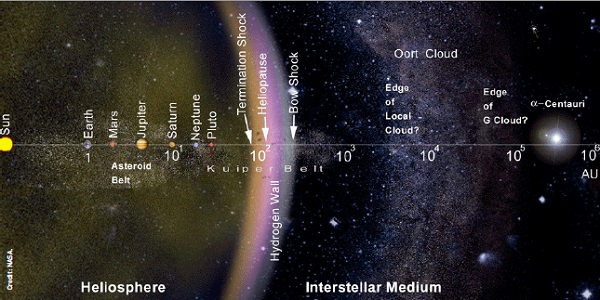 Travelling to even the nearest star would require a major technological and human effort.
Travelling to even the nearest star would require a major technological and human effort.
Daedalus, a 1973-1978 project of the British Interplanetary Society, spurred considerable advances in the field of interstellar travel. Daedalus resulted in a draft project of an interstellar probe, as well as a great number of other projects and works on the many different aspects of the problems of interstellar travel.4
Today we have major research projects such as Icarus (via the British Interplanetary Society and the Tau Zero Foundation) and the 100 Year Starship project (via DARPA and NASA).
In the century that has passed since Tsiolkovsky’s time, thousands of works tackling the problems of interstellar travel have been published. Search the AIAA database for the word “interstellar,” and you get over a thousand hits. In the last few decades, the amount of ideas and discussions has grown much faster due to the emergence of Internet resources.
Because of this, we now have the task of figuring out methods for both working with the array of information we now have and tackling the many questions to which the very concept of interstellar travel gives rise. The problems of interstellar travel must be treated as their own field of study.
The question of classification
It is best to start with organising the array of interstellar travel projects. An interstellar travel project must contain a description of the technology that can be used to conquer the distances between stars, and the description has two required elements: the method (or methods) of propulsion and the Credit: NASA. length of the flight.
Any interstellar travel project can be divided into the propulsion unit bloc and the payload. The key element of any interstellar travel project is the concept behind the propulsion unit.
As for the payload, science fiction alone gives us a wealth of possibilities, including very detailed possibilities, of what it can ultimately be.
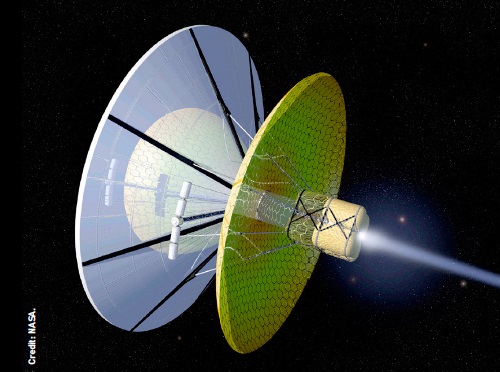 The technology to cross interstellar distances may lie in the future but thinking about the problems to be addressed can bring intellectual fruits today.
The technology to cross interstellar distances may lie in the future but thinking about the problems to be addressed can bring intellectual fruits today.
It also helps to classify interstellar travel projects on a scale of their realism, which usually correlates well with the level to which a particular travel project has been thought out (See Table 1). This ranking is the first filter one can use to select interstellar travel projects for further development or study. Once you have selected a level, you don’t have to consider projects that rank below.
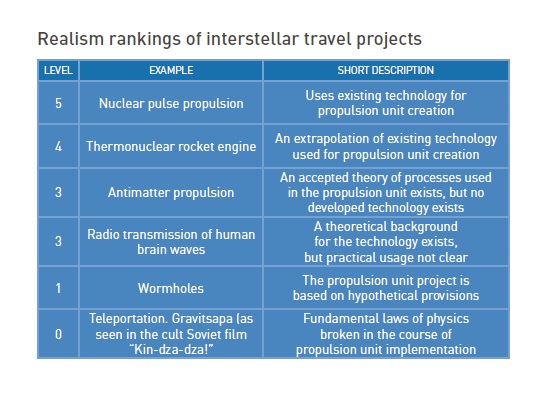
Besides looking at interstellar travel projects, we should consider the great wealth of information that originates with studies that don’t directly deal with solving the problem of propulsion, but, nevertheless, are essential to making a viable interstellar craft. The study of thermonuclear synthesis fits here, as do studies of closed life support systems and the search for and study of exoplanets. Entire fields of knowledge have grown out of the solving the issues that are directly related to interstellar travel projects (see table 2).
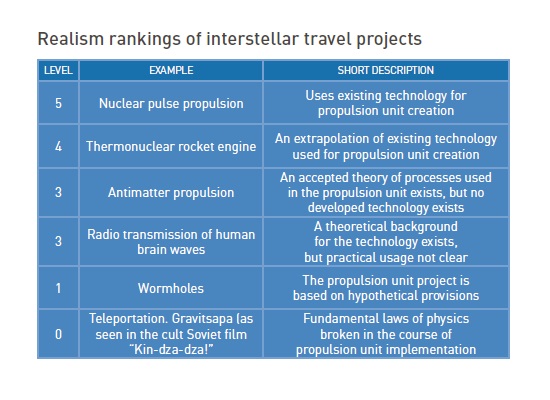
Principles of research
Principles are guidelines, basic rules, or protocols for any kind of activity. At the same time, principles are not set in stone. A principle can be rejected or modified, as long as the reasoning behind such a rejection or modification is understood and explained.
A set of principles is beneficial whether one is conducting particular research or trying to coordinate different areas of work and development. Much like rankings and classifications, principles can be used to quickly filter out obviously unpromising lines of inquiry. That being said, the researcher always chooses the so-called “harshness” level of requirements that go into judging how realistic a particular project may be.
Here is a proposed list and general descriptions of a set of principles that can be involved in making interstellar travel a reality.
1. The principle of reliance on foreseeable technologies. This principle was postulated by the Daedalus project. At its basis, it includes two provisions. First, interstellar travel is impossible if one uses technology that existed when Daedalus began (in 1973) and technology that exists today. Second, in practice, relying on technology that is not yet developed, means that work cannot continue. Having said that, foreseeable technologies – those that already have theoretical justification behind them – require only time and money for development.
2. The principle of rejecting the so-called “magic wand” of progress. This principle means rejecting a very common means of “dealing” with a complex problem. Some complex problems are not addressed, because it is reasoned that they can always be dealt with in the future. Yet we cannot burden the future with solving our problems without addressing how they may potentially be solved.
3. The principle of “financial abstraction”. There is no point in trying to determine the amount that will be spent on a particular interstellar travel project, because it is impossible to predict what the economic situation will look like 100 years from now.
4. The “humanitarian” principle. The living conditions on board a spacecraft should not be lower than average living conditions on Earth.
5. The principle of rejecting the possibility of return. Returning the crew to Earth is the main goal of manned space flight. But this only applies to flights within our own solar system. Due to the long distances and the length of the flight, a return to Earth is not just technically impossible (see Principle 1), it also doesn’t make any sense for the interstellar traveller. There is no motivation to get back to Earth.
Of course, nostalgia for the planet of one’s origin cannot be avoided, but the individual will not be able to return – only his or her descendants may one day see Earth again. And when choosing between the exploration of new worlds or a return to Earth, the former is likelier to be chosen.
In order for us to study and explore our huge galaxy, we Earthlings don’t need to send spacecraft to every star. We need only to populate about ten planetary systems in our stellar neighbourhood, in the radius of about 50 light years.
The next steps in exploration will be undertaken from already populated systems, by our so-called “subsidiary” civilisations. For Earth, after nearby star systems have been explored, the cosmic era comes to an end. It is this goal, the eventual overcoming of interstellar distances with manned spacecraft and the exploration of nearby star systems that is the ultimate “end-game” of Earth’s cosmonautics programs.5
…nostalgia for the planet of one’s origin cannot be avoided, but the individual will not be able to return…
Practical uses
Interstellar travel is something that will occur in the distant (but already foreseeable) future. At the same time, one would like to see practical results of research in the present day. Besides its obvious philosophical value, such research can effectively be used in education. And the effectiveness of it is determined by the specifics of the problem of interstellar travel – which is based in the synthesis of so many different fields in science and technology.
We should therefore not leave this problem to future generations. Although it may be many years away, the study of it has value now.
References
1: Konstantin Tsiolkovsky. Exploration of the world using reactive devices. From the book Works on Rocket Technology. Moscow: Oborongiz. 1947. P. 368.
2: Shepherd, L. R., Interstellar flight, J. Brit. Int. Soc., 1952.V.11. Pp.149-167
3: E. Zenger. Towards the mechanics of photon rockets. Moscow: Innostranaya Literatura. 1958. P. 142.
4: Project Daedalus: Demonstrating the Engineering Feasibility of Interstellar Travel. The British Interplanetary Society, 2003. P. 390.
5: I. M. Moiseyev . “The road to the stars is the longest road. “ Ekologiya I Zhizn. 2014. http://www.ecolife.ru/kosmos/22743/.





